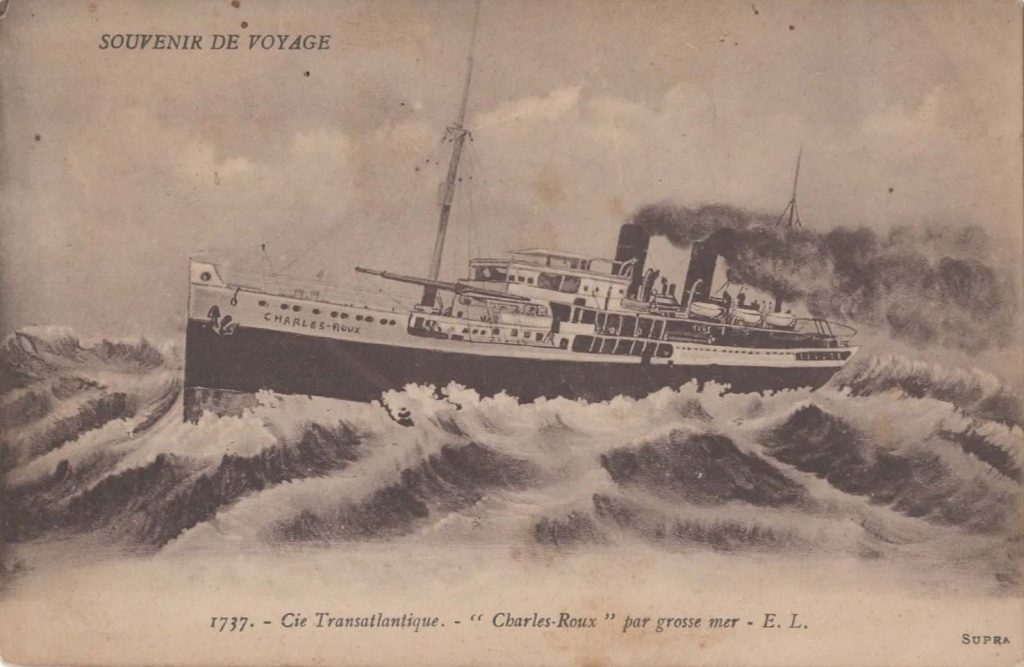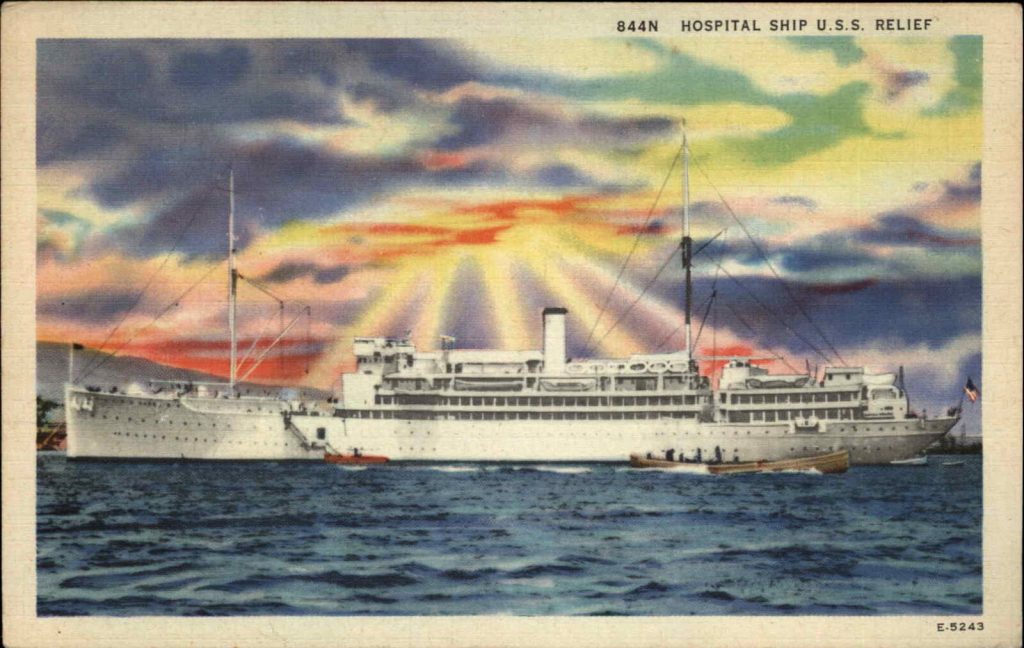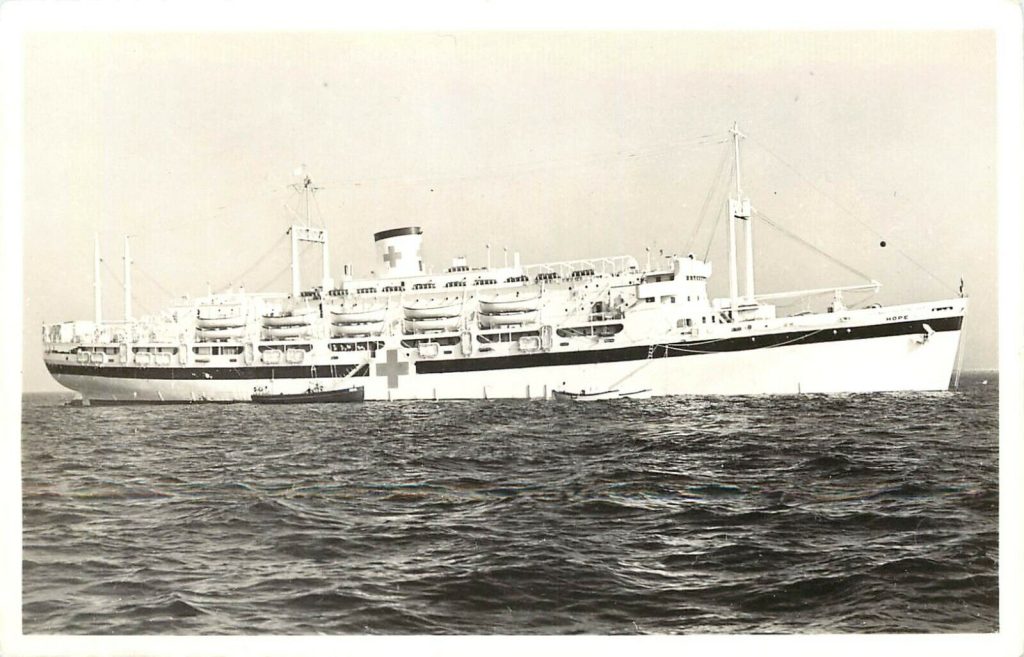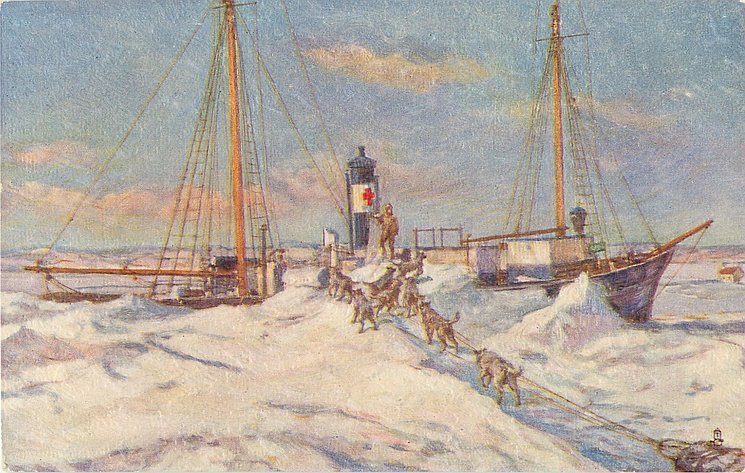Bob Teevan
The Charles Roux
Refitted for Service

This card would be an easy purchase for the collector who likes “action” postcards. The image suggests a blustery day at sea. The wind is howling and the sea is rough. The Charles Roux is plowing through but is doing so at the expense of the comfort (and perhaps, safety) of everyone on board. Interesting too, is the caption in the top-left corner: SOUVENIR DE VOYAGE which suggests that the postcard was likely available for purchased aboard.
The postcard’s caption includes par grosse mer, “in rough seas,” which seems to be somewhat of an understatement. The Cie Transatlantique refers to the vessel’s ownership by the French shipping company Compagnie Générale Transatlantique.
The vessel was no ordinary one for at its launch in 1908, she was named after Jules Charles Roux who was one of the company’s presidents. She was a passenger vessel of 4,600 tons gross and fitted with three Parsons turbines developing a total power of about 10,000 and enabling her to achieve a speed of 19 knots.
There are other postcard publishers who use the initials ‘E.L.’ which appear after the caption, but it may be safe to assume that this card was published by Émile Lacour of Marseille. This assumption is strongly influenced by the card’s postmark, Rue de La Republic in Marseille.
This card was postmarked on May 16, 1915, the message is “Marseille, the 16 of May 1915. I embark at 10 in the morning.” May we again make an assumption that the sender would be aboard when the Charles Roux left port the next day? Makes you wonder about its destination, n’est-ce pas?
The following are perhaps clues, from the Evening Mail of June 30, 1915.
“THE FRENCH RED CROSS.
HOSPITAL SHIP FOR DARDANELLES.
In view of the need for hospital accommodation for serious cases at the Dardanelles, the French government has placed at the disposal of the French Red Cross a vessel belonging to the Messageries Maritimes, the Charles Roux, which is being fitted out as a hospital ship. The coal will be provided by the French authorities, while the French Red Cross will supply the beds, the medical stores, the doctors, and the nurses. But all other supplies, such as linen, shirts, socks, handkerchiefs, and stores, besides comforts like ice machines and bedrests, must be furnished by private charity.
The Charles Roux will receive both French and British wounded, no distinction being made as regards number or treatment. It is therefore desirable that the British public should contribute as freely and as generously as possible to its requirements. The ship is required for cases that cannot be immediately transported to base hospitals. If sufficient supplies are forthcoming the Charles Roux will be able to sail in a few weeks. Consequently, gifts and contributions should be sent as speedily as possible. They should be addressed:
“Charles Roux Fund, care of Comtesse d’Hausson-ville,” or “Care of Mrs. Rosslyn Wemyss, Société de Secours du des Blesses de Guerra, 21, rue Francois I., Paris,” or “Care of Mme. de la Pantouse, French Red Cross, Knightsbridge.” Stores and other gifts in kind should be stamped with the Red Cross for transport.”
The following is from the August 13, 1915, Berkshire Chronicle and suggests that the above appeal met with some success.
BANDAGES FOR FRANCE
Several ladies of Wargrave about three months ago started a local branch of the Special Bandaging Emergency Society. A large quantity of old linen was obtained, by means of advertisements in the papers. The linen has been cut up into bandages, swabs, and pads, which are sterilized, and packed in parcels for forwarding to hospitals at the front. Miss Choate, who is the head of the Wargrave Society, sends us the following acknowledgments which she has recently received at Hyde Park Corner, London, on August 3rd.
Dear Madam, – Pray accept my warmest thanks for your parcel. What you send is most useful and much needed for our wounded on the “Charles Roux.”
Thank you again and again.
Yours very truly,
VICOMTESSE L. de la PANOUSE.
Linking the above newspaper articles is one other from the Reading Mercury of August 14, 1915.
A FLOATING OPERATING HOSPITAL
Until now the wounded at the Dardanelles have been carried to Tunis, Algeria, and the South of France before operations could be performed. A large Atlantic steamer has now been fitted up, with every device, to help the wounded, supplying everything that modern surgery requires – a first rate operating theatre, an up-to-date X-ray room, and sterilizing room. The boat is the “Charles Roux,” and on her will be the best surgeons and nurses that France can supply. Everything in the way of dressings and food will be supplied by the French Red Cross; but the boat is for British and French wounded, and the English public are asked to send comforts, such as shirts, pajamas, bed jackets, and everything that can make the men comfortable on the boat, and when they are moved after they are well enough to be taken on. The boat will be anchored as near the firing line as possible and will leave for the Dardanelles in two weeks’ time. All gifts, much or little, in money or kind, will be gladly received after being forwarded to Miss Choate, Surgical Dressing Emergency Society, Wargrave.”
It is nice to know that a postcard you own shows a vessel which played an interesting and important role in the war.
Charles Roux returned to commercial duties after the war; was converted from steam to diesel in 1928 and scrapped in 1938.
***
OTHER HOSPITAL SHIPS OF NOTE

(This image is a photograph, no postcard is known.)
There is debate on which – USS Relief or USN Red Rover – be considered the first hospital ship. “Red Rover” was a captured Confederate side-wheeler that was refitted in 1862. “Relief” was a purpose-built vessel built launched more than sixty years later. [Special note: no matter how the topic is debated, both these ships played pivotal roles in the history of women in naval service as nurses. When “Red Rover” was refitted it happened with special quarters for Navy nurses, then only a few years later, when “Relief” set sail to service the Atlantic Fleet, she did so with eleven nurses aboard – the first Navy women ever assigned to a ship’s company on sea duty.

USS Relief as seen off the coast of Cuba during the Spanish-American War.

The SS Hope made the first of its ten voyages in 1969 to Viet Nam. One special piece of equipment was a machine called the Iron Cow. Using distilled seawater, combined with milk solids and butterfat, it was capable of turning out 1,000 gallons of milk daily. This 15,000-ton ship had a pharmacy, three operating rooms, a radiology department, an isolation ward, and closed-circuit television for viewing operations. The medical crew typically consisted of 150 nurses and 100 doctors.

The ship seen here was built by the Devon shipyard of Philip and Son in 1899. It was the first to be named Strathcona. This vessel was equipped with a modern dispensary and x-ray apparatus, possibly the first designed for use at sea. In addition to providing basic clinical services the Strathcona also acted as a marine ambulance, floating court, and a travelling church. The current ship with this name once sailed for the Canadian Coast Guard as an icebreaker. The new Strathcona was converted to a hospital ship in 2004.

Cunard’s Aquitania was an ocean liner that served with distinction for 36 years as a liner, troop ship, and hospital ship. “Aquitania” was the third in Cunard’s trio of express liners, preceded by “Mauretania” and “Lusitania,” and the last of the four-funnel ocean liners. Soon after her launch in April 1913 World War I broke out and she was converted to a troop transport and then a hospital ship that served as part of the Dardanelles Campaign alongside the “Charles Roux.”
I remember an article about SS Hope appearing in a copy of either “My Weekly Reader” or Scholastic “NewsTime” during my elementary-school days.
This was interesting and a nice history lesson. Great photos as well. Well done Bob.